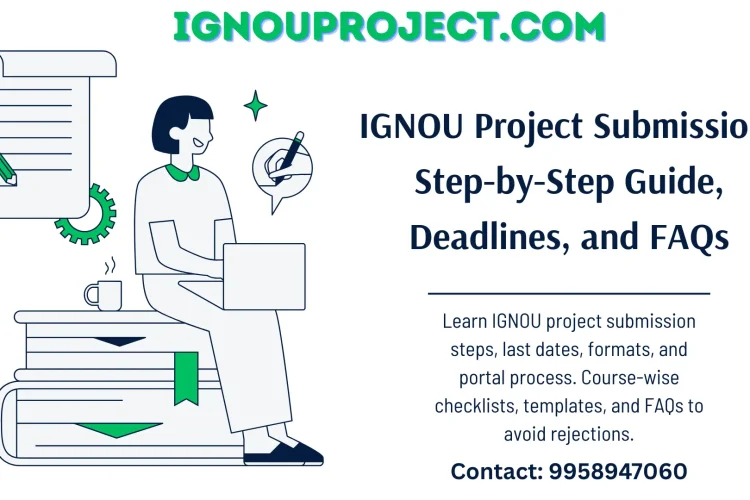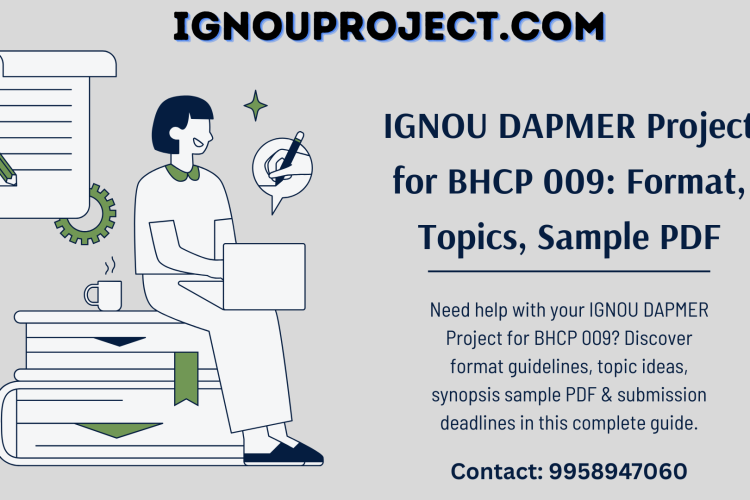
The IGNOU MAEOH Project (MEVP 1) is a mandatory component of the Master of Arts in Environmental and Occupational Health (MAEOH) courses offered by Indira Gandhi National Open University (IGNOU) in India. It’s designed to bridge the gap between theoretical knowledge and practical application in the field of environmental and occupational health.
Whatsapp us to get the Personalized (Customized) IGNOU MAEOH Project Report and Synopsis
Download PDF Link for IGNOU MAEOH Project for MEVP 1
How do you choose a topic for your IGNOU MAEOH Project?
Choosing a good topic for your MEVP 1 project requires considering a few key factors:
- Your Interests: Pick a topic that genuinely interests you. This will make the research process more engaging and enjoyable. Think about environmental or occupational health issues you find personally compelling or areas where you see yourself making a future contribution.
- Program Alignment: Ensure your topic aligns with the curriculum of the MAEOH program and explores a relevant issue in environmental and occupational health. Review your course materials and the IGNOU handbook (MEVP001) for guidance on appropriate topics.
- Feasibility: Consider the practicalities of researching and completing your IGNOU MAEOH Project. Are there sufficient resources available to explore your chosen topic? Does the timeframe allow for in-depth research and data collection?
- Scope: Aim for a topic that’s specific enough to be manageable within the project’s scope but broad enough to allow for a thorough investigation. A topic that’s too broad might be difficult to research effectively, while one that’s too narrow might limit your exploration.
Here are some additional strategies to help you brainstorm potential topics:
- Current Events: Look for recent news articles or reports that highlight environmental or occupational health concerns. Could you delve deeper into a specific aspect of these issues through your project?
- Workplace Issues: If you have current or past work experience, consider potential safety hazards or health risks specific to your field. Are there areas where research could contribute to improved working conditions?
- Community Concerns: Are there environmental issues in your local community, such as air or water pollution? You could explore the health impacts of these concerns or potential solutions.
- Academic Literature: Review academic journals or research papers related to environmental and occupational health. Identify areas where there are knowledge gaps or where further investigation is needed.
- Discuss with Advisor: Talk to your academic advisor about your interests and potential project ideas. They can provide valuable insights and guidance on selecting a feasible and relevant topic.
Some examples of IGNOU MAEOH project topics
- Environmental Degradation In Kangra District Of Himachal Pradesh
- Attitude, Awareness And Practice Of Women Of Shimla District, Himachal Pradesh Towards Environmental Protection
- To Assess The Awareness Among Women About Their Role In Environment Protection With Special Refernece To Hooghly District Of West Bengal
- Menance Of Global Warming: A Socio-Legal Study
What is the format of the IGNOU MAEOH Project Report?
The project report should follow the prescribed format by IGNOU, which typically includes:
- Title page
- Declaration
- Certificate of originality
- Acknowledgements
- Table of contents
- List of tables/figures
- Introduction
- Literature review
- Research methodology
- Data analysis and interpretation
- Conclusions and recommendations
- References
- Appendices
Are there any resources available to help you complete the MEVP 1 Project?
Yes there are several resources at your disposal to help you complete your project
Official IGNOU Resources:
- MEVP001 Project Handbook: This handbook serves as the primary guide for students undertaking the MAEOH project. It provides detailed information on various aspects of the project, including:
- Formulating a research proposal
- Conducting research using appropriate methodologies
- Writing a well-structured project report
- Submission and evaluation procedures [RC Chandigarh, IGNOU]
- Programme Guide: The IGNOU MAEOH Programme Guide outlines the structure of the program, including the project component. It can help you understand the project’s purpose and its role within the overall curriculum IGNOU MAEOH Programme Guide.
Academic Support:
- Academic Advisor: Your academic advisor is a valuable resource throughout your project journey. They can provide guidance on:
- Selecting a suitable project topic
- Understanding project requirements and expectations
- Choosing appropriate research methodologies
- Interpreting feedback on your proposal or report
External Resources:
- Libraries: Utilize university libraries or online library resources to access academic journals, research papers, and books related to environmental and occupational health.
- Government and NGO Reports: Government agencies and non-governmental organizations (NGOs) often publish reports on environmental and occupational health issues. These reports can provide valuable data and insights for your project.
- Credible Websites: Look for websites of reputable organizations like the World Health Organization (WHO) or the United Nations Environment Programme (UNEP) for reliable information on environmental and occupational health topics.
What kind of research methodologies can be used in IGNOU MAEOH Project?
The most suitable research methodology for your MEVP 1 project depends on your specific topic and research objectives. However, here’s a breakdown of some common methodologies used in environmental and occupational health research:
Quantitative Methods:
- Literature Reviews: Involve systematically analyzing existing research related to your topic. This helps build a foundation for your project and identify knowledge gaps you can address.
- Surveys: Effective for gathering data from a large population group through questionnaires or interviews. Surveys can help assess exposure levels to environmental hazards, prevalence of occupational illnesses, or attitudes towards safety practices.
- Field Studies: Involve collecting data directly in the environment or workplace setting. This could involve measuring air or water quality, monitoring noise levels, or observing safety protocols.
- Experiments: Less common in MAEOH projects due to ethical considerations and resource.
Qualitative Methods:
- Case Studies: In-depth exploration of a specific individual, group, or event related to your topic. Case studies can provide rich insights into the lived experiences of people affected by environmental or occupational health issues.
- Interviews: In-depth conversations with key informants like experts, workers, or community members. Interviews help gather qualitative data on perceptions, experiences, and perspectives related to your research question.
- Focus Groups: Discussions with a small group of individuals who share similar experiences or characteristics. Focus groups can reveal shared concerns, generate ideas, and explore group dynamics related to environmental or occupational health issues.
Mixed Methods:
Many projects benefit from a mixed-method approach that combines quantitative and qualitative data collection techniques. This allows for a more comprehensive understanding of the research question by capturing both the objective data and the lived experiences of those affected.
Are there any statistical tools or software required for data analysis?
The specific statistical tools or software required for your IGNOU MAEOH project depend on the complexity of your chosen topic and the type of data you collect. Here’s a breakdown of what you might encounter:
Basic Statistical Analysis:
- Many projects can be analyzed using fundamental statistical methods.
- Tools like Microsoft Excel offer functionalities for calculating basic statistics like mean, median, standard deviation, and even performing simple hypothesis testing.
- This might be sufficient for projects involving relatively straightforward data sets, such as surveys with Likert scale responses or basic measurements like air quality readings.
Advanced Statistical Analysis:
- If your project involves more complex data sets or requires in-depth statistical analysis, you might need to consider dedicated statistical software.
- Popular options include:
- SPSS (Statistical Package for the Social Sciences): user-friendly software offering a wide range of statistical tests, data visualization tools, and capabilities for handling complex data structures.
- R: A powerful open-source programming language widely used in statistics and data analysis. It offers greater flexibility but has a steeper learning curve compared to user-friendly software like SPSS.
Choosing the Right Tool:
- Discuss with your advisor: They can assess the complexity of your data and recommend appropriate statistical tools or software based on your skillset and project requirements.
- Consider online resources: Many universities or online platforms offer tutorials and introductory courses on basic statistical analysis using Excel or introductory courses on SPSS or R.
- Focus on feasibility: While powerful software exists, prioritize tools that you can learn and utilize effectively within the timeframe of your project.
Can you re-submit your IGNOU MAEOH Project if it’s not approved the first time?
Yes, you can usually re-submit your MEVP 1 project if it’s not approved the first time. Here’s a breakdown of the process:
Feedback and Revision:
- When your project proposal is not approved, you’ll typically receive feedback from your advisor or a review committee highlighting the areas where your proposal needs improvement.
- Carefully analyze the feedback to understand the reasons for rejection. It might be related to the clarity of your research question, the feasibility of your methodology, or insufficient justification for your chosen topic.
Revision Process:
- Based on the feedback, revise your project proposal to address the identified shortcomings.
- This might involve refining your research question, strengthening your methodology, or providing additional details to demonstrate the feasibility and significance of your project.
- Discuss your revisions with your advisor throughout the process to ensure you’re on the right track.
Re-submission:
- Once you’ve thoroughly revised your proposal, consult your advisor or program coordinator regarding the re-submission process.
- There might be specific deadlines or procedures to follow for re-submitting a revised proposal.
- It’s crucial to adhere to these guidelines to ensure your re-submission is considered.
Ready to get your IGNOU MAEOH Project Report and Synopsis Sample PDF for MEVP 1?
- Call us or WhatsApp us at: 9958947060, 9354637830
- Visit: IGNOUPROJECT.COM

